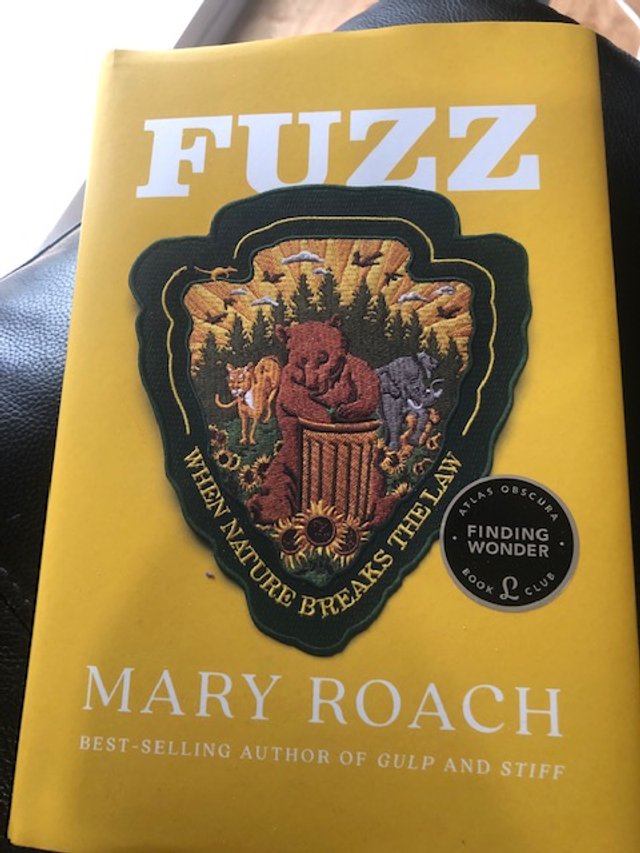Fuzz: When Nature Breaks the Law by Mary Roach
If you’ve never heard of or read Mary Roach, I encourage you to check her out! She writes super interesting books and they are funny. I think I first heard of her on NPR. Here’s a link to an interview on “Fresh Air” where she’s talking about one of her other books, Gulp. My daughter has read several of her books, too, and loved them. This book, Fuzz: When Nature Breaks the Law, is about the many times nature interferes with humans and what they want to do, where they want to live, and so on.
This book has footnotes, and like another book I read with footnotes, A Heartbreaking Work of Staggering Genius by Dave Eggers, you don’t want to miss them! Here’s one example:
*A technique favored by Mussolini’s squadristi thugs. Political foes were force-fed large quantities of castor oil—up to a quart, according to The Straight Dope. Who does that? Moreover, why? To kill by dehydration? To humiliate? I could find no satisfying answer, not even from the International Castor Oil Association, which, despite large quantities of emails, had no comment.
As you can tell by this quote, Roach’s writing style is engaging and friendly. You feel like you’re talking with your super smart, interesting best friend, who has the same reactions as you to whatever she’s talking about, and who laughs at the same things you do. I love her plays on words, examples of which you can see in her chapter titles:
MAUL COPS: Crime Scene Forensics When the Killer Isn’t Human
BREAKING AND ENTERING AND EATING: How Do You Handle a Hungry Bear?
THE ELEPHANT IN THE ROOM: Manslaughter by the Pound
A SPOT OF TROUBLE: What Makes a Leopard a Man-Eater?
THE MONKEY FIX: Birth Control for Marauding Macaques
MERCURIAL COUGARS: How Do You Count What You Can’t See?
WHEN THE WOOD COMES DOWN: Beware the Danger Tree
THE TERROR BEANS: The Legume as Accomplice to Murder
OKAY, BOOMER: Failed Military Actions Against Birds
ON THE ROAD AGAIN: Jaywalking with the Animals
TO SCARE A THIEF: The Esoteric Art of the Frightening Device
THE GULLS OF ST. PETER’S: The Vatican Tries a Laser
THE JESUIT AND THE RAT: Wildlife Management Tips from the Pontifical Academy for Life
KILLING WITH KINDNESS: Who Cares About a Pest?
THE DISAPPEARING MOUSE: The Scary Magic of Gene Drives
“Maul Cops.” :D
Roach delights in the idiosyncrasies of the people she meets as she researches her topic. Here she talks about a conference she went to for WHART—Wildlife-Human Attack Response Training—in British Columbia. She describes following several participants to lunch:
Their leather hiking boots squeak as they walk. “So she looks in her rearview mirror,” one is saying, “and there’s a bear in the back seat, eating popcorn.” When wildlife officers gather at a conference, the shop talk is outstanding. Last night I stepped onto the elevator as a man was saying, “Ever tase an elk?”
Besides chuckling and grinning as you read, you learn a whole lot about animals and nature, the people in charge of protecting them and us (in the U.S. and several other countries), and some of the paradoxical dilemmas we face as we try to figure out how to live peaceably with the animal kingdom. (See what I did there?)
Roach writes about many different methods of controlling animals—or at least trying to—things such as trapping and relocating, “the lethal method” (killing the animals), gene therapy, and more. Often, just as with training animals, the method with the most chance of success is changing humans’ behavior. So often we encourage the animals to do exactly what we ask those in agencies created to handle animals’ “bad” behavior. We leave garbage out, we feed wild animals, and so on. But Roach is never giving you a know-it-all, goodie-two-shoes lecture. She tells stories about both the animals and the people involved and you can see the sometimes seemingly insoluble problems we face. She doesn’t leave you feeling hopeless about it, though. I came away admiring the people who deeply love both the animals and the humans involved, enough to dedicate their careers to the work of saving and protecting both.
One that I found really interesting was a man, Justin Dellinger, who leads the Statewide Mountain Lion Project in California. He is one of a very few expert trackers left in the world. I’ve always been fascinated by the art of tracking. It’s amazing what-all he uses to figure out what animal made the track, when, and why. The shape of the track is a big factor, of course, its size, but also the “crispness” of the soil, the other tracks around, how far apart the tracks are, if they’re messy or scuffed or overlapping. Amazing.
I highly recommend Fuzz. You’ll have fun reading it, come away knowing a little more, and still with hope that things will get better. I plan to read more of her books.
